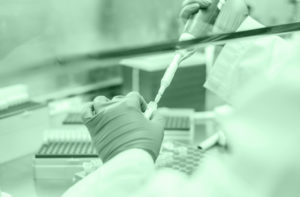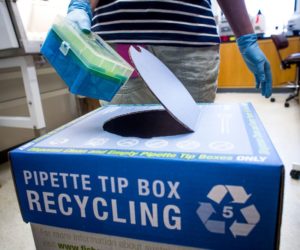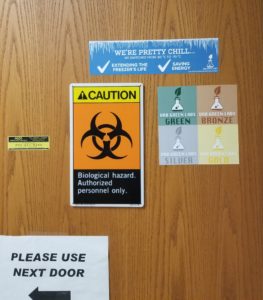Do you love your research job? What if you couldn’t do that work anymore? What if future researchers couldn’t have the opportunity to build from what you have accomplished and feel the same joy you do about their research?

Unfortunately, these may become more than hypotheticals for the next generation of scientists due to the impact humans are having on the earth. Scientific research has an outsized impact on some aspects of our unsustainable use of resources. Academic research buildings can use four times more energy than a typical office building and can be responsible for one-third of all waste generated on campus. So, can you make scientific research more sustainable?
Well, there’s really no excuse not to according to Nick Ciancio, the 2019 Green Labs Coordinator at the University of Alabama Birmingham. Nick, who recently graduated with a BS in Neuroscience, stepped into this role as the result of an internship he received through the UAB Sustainability Office. After meeting the CEO of My Green Lab, Allison Paradise, at a CDC conference on sustainability, his supervisor asked him to start a Green Labs program on their campus. Although UAB had established a sustainability program on campus, there hadn’t been a focus on laboratory spaces up to that point.

Nick, who has always been passionate about sustainability, was happy to take on this role. “I’m a big believer that if you can recycle something, you’d better recycle it or if something is on and it doesn’t need to be on, then it should be turned off.” He knew how much waste was generated in labs from his own research experience, but had no idea how unsustainable and pervasive this wastefulness was within the research community.
He had actually approached his research mentor, a graduate student, about this and her response was, “all the undergrads think they can change the world, but lab waste is lab waste and we can never reduce it.” He found it unfortunate that future researchers were receiving the message that waste in the lab was always going to be that way and there was nothing that could be done about it. This would become a common refrain from researchers when he approached them about participating in the UAB Green Labs program.
“It’s an educational issue,” Nick says matter-of-factly. Education is exactly how the UAB Green Labs program tackles the issue of lab sustainability on campus. Nick started a pilot program to see if researchers would be interested in making their labs greener, offering participants the chance to win an ultra-low temperature freezer. Nick gave educational presentations about sustainability to labs across campus, requiring 50% of lab personnel to attend and distributed a survey developed by Allison from My Green Lab. The results of the survey were analyzed and used to help implement changes within these labs.
One question on the survey caught Nick’s attention: Do you send back pipette tip boxes to vendors that take them back to recycle them? He found a vendor with a recycling program but discovered that it required buying 5 boxes (at a cost of $120), which wasn’t appealing to many labs. Although a few labs did participate, the vendor discontinued that program shortly after, leaving Nick scrambling for another solution. As an undergrad, the pressure was on to prove that he and his new program could be taken seriously.
After some research, he found a recycling center in Alabama that takes the same type of plastic pipette tip boxes are made of. He also inquired about what other plastics they could recycle and it turned out they would take just about everything. Nick decided to expand their recycling program beyond pipette tip boxes, which required hiring someone just to manage the lab recycling component of the UAB Green Labs program.

The survey was modified to incorporate information about the expanded recycling options. Since labs were eager to find a way to recycle, this opportunity was an important incentive to encourage participation—you can’t recycle if you aren’t part of the UAB Green Labs program. As a result, program participants are now able to recycle all #4 and #5 plastics, styrofoam, glass, and #1 and #2 plastics that aren’t bottles.
Energy conservation is another key component of the program. Although small changes can make a big difference, the impact is not as visible as recycling and it’s harder to get participants excited about making behavioral changes that can be perceived to affect research outcomes. There is also a lot of mythology related to equipment affecting energy consumption that persists in labs, despite more knowledge and advances in technology (i.e. choosing a PCR holding temperature of 4°C versus room temperature).
Nick distributed power strips and outlet timers to participating labs, allowing equipment that would normally be on 24/7 to be turned off overnight for 10 or more hours. Besides saving energy, it extends the life of the equipment. Labs were also encouraged to turn off lights and equipment (such as tissue culture hoods) when not in use, close fume hood sashes and adjust their PCR holding temperature. Even something that seems as negligible as not using screensavers can make a difference. At UAB, reducing the amount of energy used to power laptops for all 1,500 research staff adds up.
Freezers are another big focus for energy conservation that are unique to research labs. If every lab at UAB changed their freezer temperature set point from –80°C to –70°C, the campus could save $100,000 in energy costs. While this small change may seem like a no-brainer, if you’ve ever kept research samples in a freezer you can imagine the potential concerns.

Entrusting your life’s work in a freezer at a new temperature is a scary proposition, which Nick recognized when speaking with researchers 1-on-1 about why they hadn’t “chilled up” their freezers. Luckily, scientists at CU Boulder and UC Davis (along with other institutions) have created a database of samples that can be safely stored at –70°C, which researchers can reference to put their minds at ease.
In addition, UAB Green Labs has recently started performing freezer energy audits in each lab building to determine which are the most inefficient and evaluate if UAB can fund their replacement. There are also a few “stand-by” freezers provided by UAB for researchers to use when defrosting their primary freezer.
Another effective strategy for Nick has been organizing a number of year-long, building-wide pilot programs that ask all residents to enroll in UAB Green Labs. These programs effectively illustrate how taking a few steps to do research more sustainably can significantly reduce energy consumption and waste generation (or at least reduce the amount of landfill waste), as well as save money—which is not something you can typically expect in such a short time frame.
During one pilot program that enrolled nearly every lab in the building, UAB Green Labs was able to demonstrate that, through behavioral changes alone, they were able to reduce energy usage by 620,000 kW hours. That’s as much energy as 62 homes use in an entire year!
Speaking of a lot of energy, let’s talk about autoclaves. In a single year, an autoclave will use as much energy as one home does in 50 years! This makes it crucial that an autoclave is only run when full, which can be a challenge for small labs that might take an entire year to have enough stuff to fill it. Nick instructs researchers to work with neighboring labs to help fill an autoclave before running it.
Autoclaves can also put strain on A/C systems when doors are left open, releasing additional heat and humidity into a building. One day on a walk through a building, Nick found every single autoclave door open. Keeping the door closed is a simple solution, but the real challenge was finding an effective way to communicate this message given the number of people involved and frequent turnover. Nick decided to return to the building and put stickers on the doors of every autoclave reminding users to close them. Within a week, every autoclave door was shut when not in use and Nick still observes 100% compliance when he performs random checks in these labs.

Stickers are a common theme for the UAB Green Labs program. Some serve as effective reminders for the behavioral changes needed to make the labs more sustainable, like putting stickers on equipment that direct researchers to Turn of after each use, Ask before turning off or Never turn off. Other stickers make labs not participating aware of sustainability efforts that are part of the program, such as the We’re pretty chill stickers labs receive when they raise their freezer temperature.
In addition, their use of stickers also fosters a friendly level of competition for participants. Nick distributes certification level stickers to participants based on how many different sustainability efforts they are making in their lab. For example, a bronze-certified lab might be recycling, turning off lights, setting their freezer at –70°C and following autoclave guidelines. Participants that aren’t certified yet may see a green level sticker on the lab door across the hall and ask what they can do to get the same certification (or do better, maybe silver or gold).

Unfortunately, not all researchers are convinced or motivated by these subtle messages to be more sustainable. Nick often finds that the labs where he has made a personal connection become the most active participants of the program. He strives to demonstrate that he cares about them and makes a point to ask, “How can we make it easier for you to do your research?” and help find solutions.
Most of the people Nick presents to are interested in reducing the environmental impact of their lab, they just don’t know where to start. He focuses on easy changes that can make a difference like turning of lights and equipment, using powerstrips and outlet timers and resisting the urge to overpurchase supplies and reagents, which can lead to waste when unused items expire.
Sometimes PI’s will resist even these simple changes and tell Nick, “I don’t care about sustainability.” In response, the UAB Green Labs program has created a boilerplate template for researchers to use once they’ve joined the program. The template can be submitted with grant applications to indicate their certification level and what sustainability efforts are going on in their lab. This information can put a lab in a better position to obtain grant funding, particularly from the NIH and NSF, which is a great incentive for participation by otherwise unwilling researchers.
Despite these challenges, Nick has built a successful sustainability program at UAB. But there’s still more work to be done. While there are currently 100 labs on campus enrolled in the UAB Green Labs program, his goal is to double the number of labs participating. In addition to recycling and energy consumption, water usage is the next focus of the program. One strategy is to make sure labs are selecting the appropriate quality of water for their work—for example, foregoing distilled water when tap water will suffice.
Equipment that relies on water is something else Nick and his team are finding alternatives for. Encouraging researchers to update their lab with more efficient autoclaves is one strategy to conserve water. Another opportunity is replacing traditional condensers common in chemistry labs. The UAB Green Labs program has purchased a waterless condenser that labs can try out and evaluate as a potential replacement.
No matter what aspect of the program Nick is working on, his primary objective is to help researchers remember why they are doing their work. “We want to make sure that they know the research they are performing is important, but it’s also important that they do it in a sustainable manner so future generations can build on the work that they’ve done.”
Click here to learn more about My Green Lab and how to make your lab more sustainable.
Latest posts by Darcia Schweitzer (see all)
- Cytochrome P450 Inhibition: Old Drug, New Tricks - May 5, 2022
- Firefly Luciferase Sheds Light on Development of New Malaria Treatments - April 5, 2021
- How to Train Your Instrument Service Team in a Pandemic - February 1, 2021

As a distributor of autoclaves that conserve water and energy by design (rather than line item options), we’re delighted to see the emphasis on updating laboratory equipment to avoid waste in the first place. We’d like to help consumers distinguish between on-demand autoclaves (like ours) and 24/7 steam-jacketed units. There’s a tradeoff for the sustainable choice: liquid cycles take longer to cool in an on-demand autoclave. If you’re running more than 5 cycles/day, you may need a jacketed unit. If you’re in a typical research lab, and you run a fewer than 6 media, waste, glassware, or QA cycles in a day, upgrading to the sustainable choice may be simple.